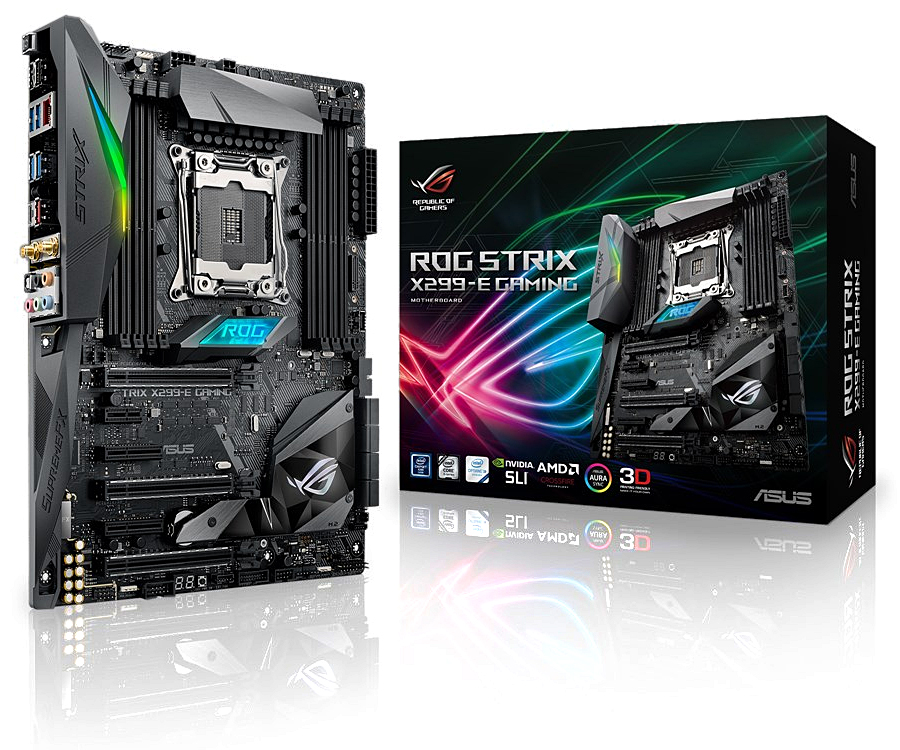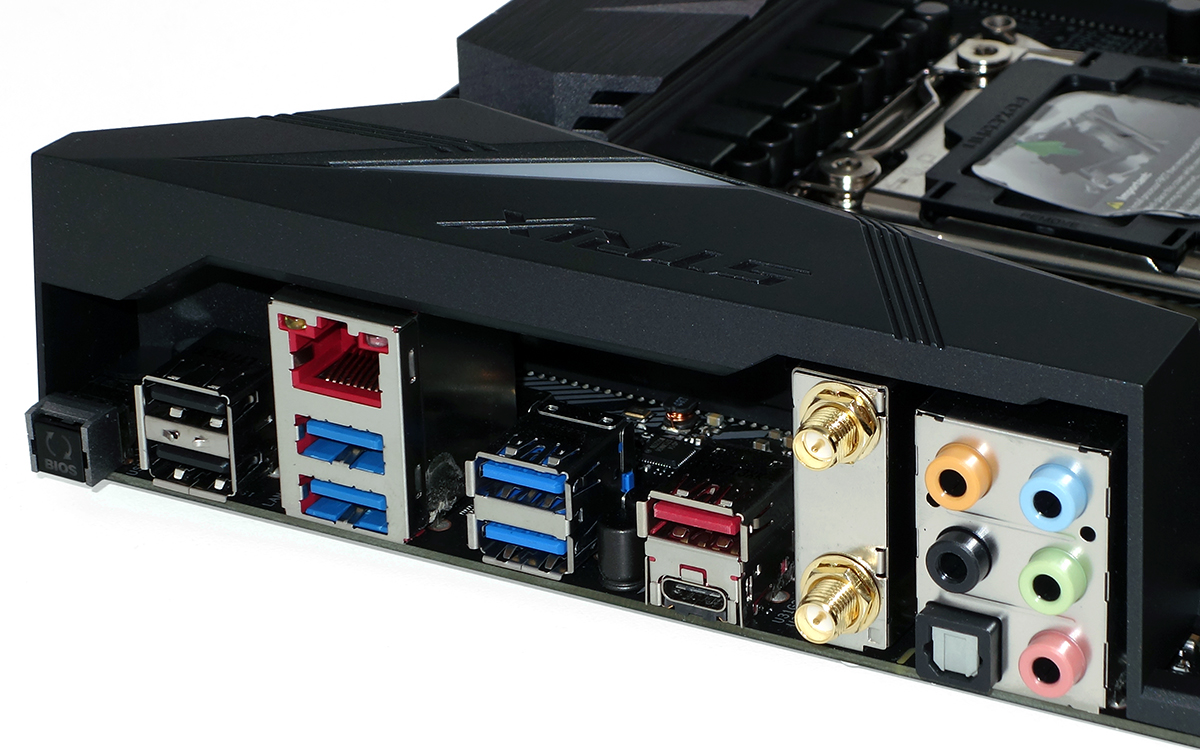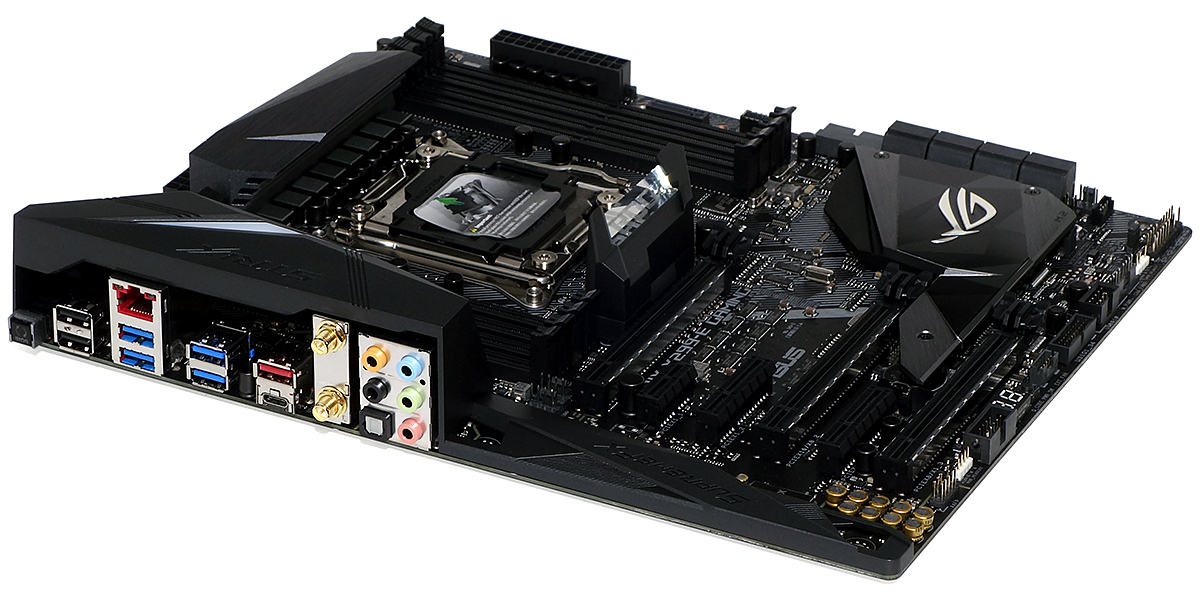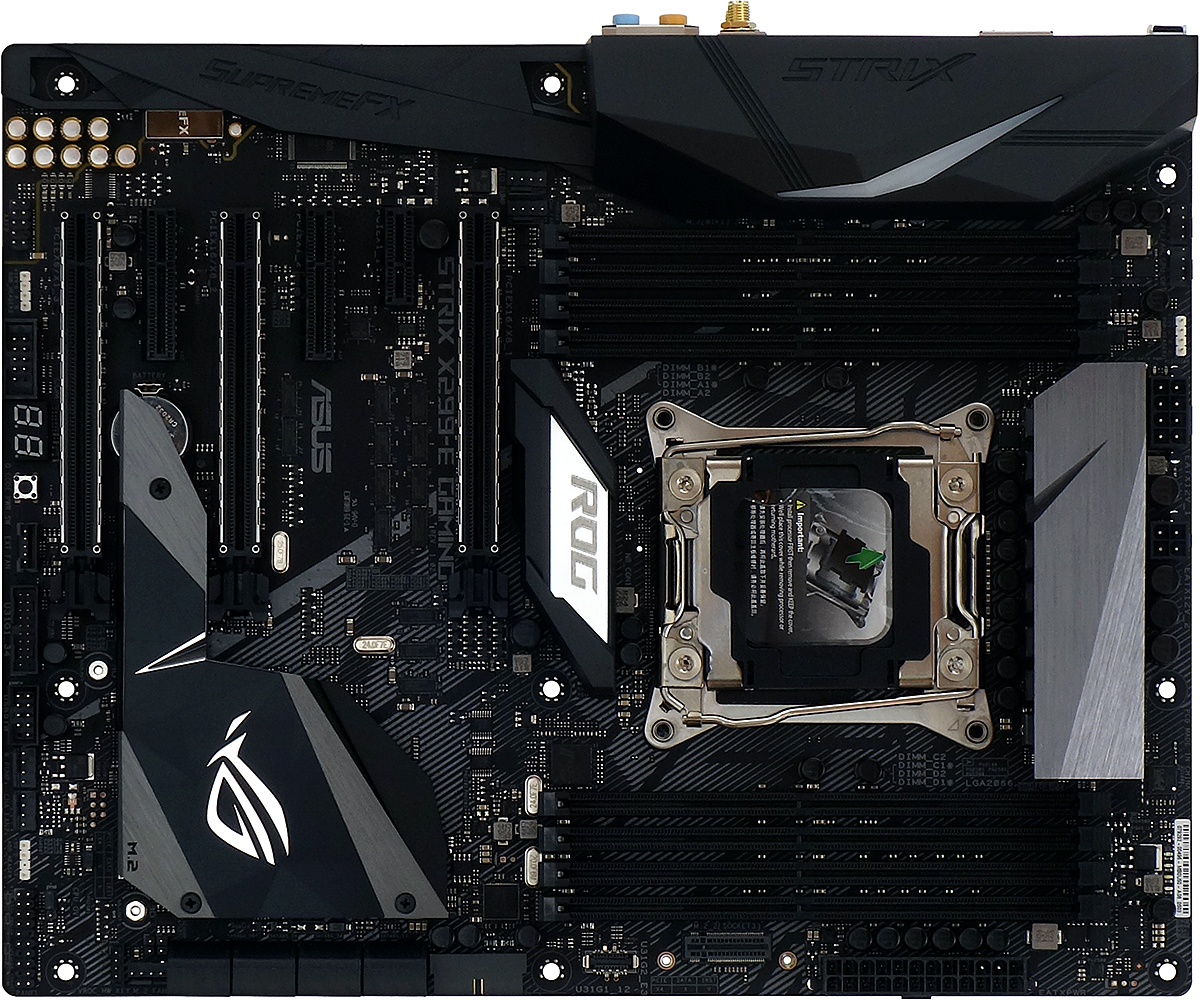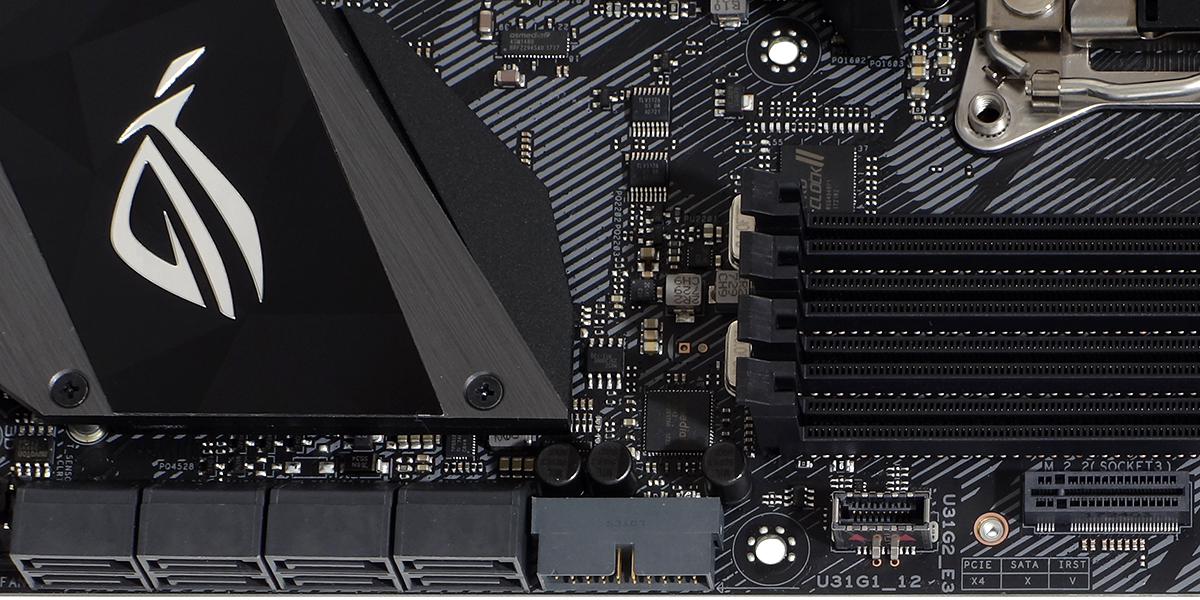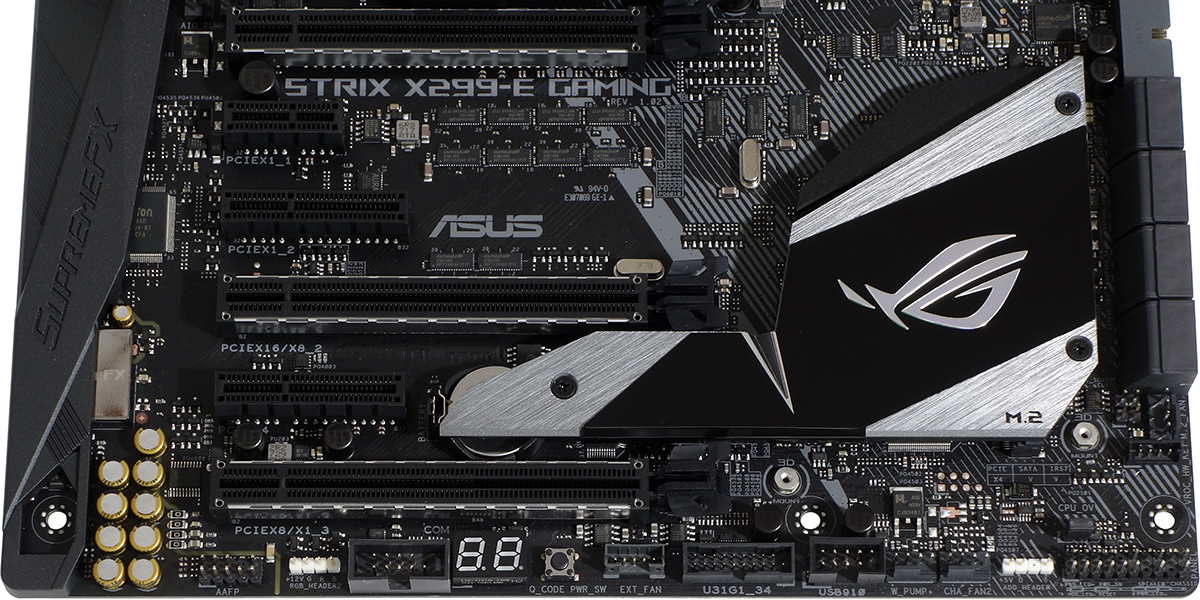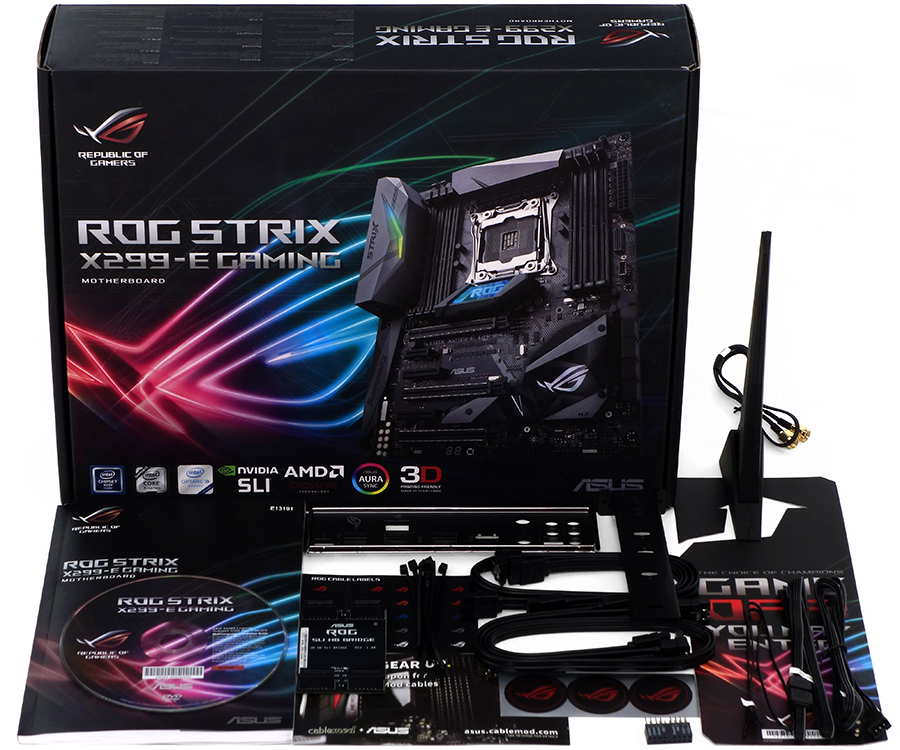Tom's Hardware Verdict
The ROG Strix X299-E Gaming is a strong contender for buyers with 44-lane Core-X CPUs. But its unacceptable slot configuration with 28-lane processors prevents any broader recommendation.
Pros
- +
Good overclocking
- +
Efficient in terms of heat and power
- +
Solid on-board lighting and control software
- +
867Mb/s Wi-Fi controller adds value
Cons
- -
Fewer features per dollar than closest competitor
- -
Third graphics card slot hampered by 28-lane processors
Why you can trust Tom's Hardware
Layout & Features
The idea of a $300 board being mainstream might sound ludicrous, but entry-level X299 boards cost around $200, and Intel’s high-end desktop series is designed for big spenders. Mid-level might be a better term for this price, and the Asus ROG Strix X299-E Gaming (which sells for at or just under $300 when we wrote this) gets there with a combination of dual USB 3.1 Gen2 controllers, a 867Mb/s Wi-Fi module, enhanced overclocking and competitive RGB lighting features.
Specifications
| Socket | LGA 2066 |
| Chipset | Intel X299 |
| Form Factor | ATX |
| Voltage Regulator | Eight Phases |
| Video Ports | ✗ |
| USB Ports | 10Gbps: (1) Type-C, (3) Type A 5Gb/s: (4) Type A; (2) USB 2.0 |
| Network Jacks | Gigabit Ethernet, (2) Wi-Fi Antenna |
| Audio Jacks | (5) Analog, (1) Digital Out |
| Legacy Ports/Jacks | ✗ |
| Other Ports/Jack | USB BIOS Flashback I/O-Panel Button |
| PCIe x16 | (3) v3.0 (@44: x16/x16/x8) @28: (x16/x8/x1) @16: (x16/x0/x1, x8/x8/x1) |
| PCIe x8 | ✗ |
| PCIe x4 | (2) x4*/x1 (*Consumes SATA ports 5-8) |
| PCIe x1 | (1) v3.0 (Consumes front-panel USB 3.1 Gen2) |
| CrossFire/SLI | 3x / 3x |
| DIMM slots | (8) DDR4 |
| M.2 slots | (1) PCIe 3.0 x4 / SATA*, (1) PCIe 3.0 x4, (1) Key-E (Filled); (*Consumes SATA port 1) |
| U.2 Ports | ✗ |
| SATA Ports | (8) 6Gb/s (Ports 1, 5-8 shared w/M.2, PCIe x4) |
| USB Headers | (1) 10Gb/s Type-C*, (2) v3.0, (1) v2.0 (*Shared w/PCIe x1) |
| Fan Headers | (7) 4-Pin, (1) Extender Card Header |
| Legacy Interfaces | Serial COM Port |
| Other Interfaces | FP-Audio, (2) RGB-LED, ADD-RGB, VROC_Key, Thermistor |
| Diagnostics Panel | Numeric |
| Internal Button/Switch | Power |
| SATA Controllers | Integrated (0/1/5/10) |
| Ethernet Controllers | WGI219V PHY |
| Wi-Fi / Bluetooth | RTL8822BE 802.11ac 2x2 (867Mb/s) / BT 4.2 Combo |
| USB Controllers | (2) ASM3142 PCIe 3.0 x2, ASM1074 Hub |
| HD Audio Codec | ALC1220 |
| DDL/DTS Connect | ✗ |
| Warranty | 3 Years |
Unlike many mid-level boards though, the ROG Strix X299-E Gaming requires a 44-lane CPU to effectively use its third x16-length PCIe slot. Although it's a solid-enough board to encourage a few buyers, that limitation is a big hindrance to our overall recommendations.
The Strix X299-E Gaming has two antenna connections for Realtek’s 2T2R 802.11ac module and two ports (Type-C and Type A) for ASMedia’s PCIe 3.0 x2 USB 3.1 Gen2 controller on its I/O panel. There's also a USB BIOS Flashback button, which uses a special ASIC (application-specific integrated circuit) to enable flashing firmware without the need for a compatible CPU or DRAM. Other I/O panel features include four USB 3.0 (aka USB 3.1 Gen1), two USB 2.0, digital optical audio output and five analog audio jacks.
Zooming out shows the extremes Asus went to for the board to represent the ROG brand aesthetically, from the lighted sliver on the I/O connector hood, to the machined aluminum voltage regulator sink, the M.2 heat spreader integrated into the PCH sink cover and ROG lightbox badge at the motherboard's center. Two open-ended PCIe x4 slots add to the three x16 slots to boost enablement of serious connectivity.
Given the board’s support for everything from 44-lane to 16-lane processors, you’d expect to see the double-row of eight two-lane PCIe switches under its top slot. The surprise comes in the other three switches to the side of that group, as the lower PCIe x4 slot steals all four HSIO resources (Intel’s flexible SATA/USB3/SATA pathways) from SATA ports 5-8. And if you were thinking of using the PCIe x1 slot instead, note that doing so will switch off the front-panel USB 3.1 Gen2 connector. Given that you’ll probably have a graphics card covering the x1 slot, you might be un-enthused to learn that the upper PCIe x4 slot has only one pathway.
Compromises on the smaller slots are understandable to those familiar with Intel’s chipset limitations, particularly given the market’s focus on x16 slots. While a 44-lane CPU can shoot an x16/x16/x8 configuration and x16 processors spit an x8/x8/x1 configuration by borrowing a lane from the chipset, options for 28-lane processors teeter on the edge of infuriating: Asus says the top slot is locked at x16 mode with those processors, the middle slot gets eight CPU pathways, and the lower slot still gets only a single pathway from the chipset. Asus gives no excuses or explanations for why it couldn’t do a three-by-eight configuration for three-way SLI on 28-lane processors, nor does it say why the CPU’s other four lanes are ignored.
Layout is fairly good in spite of configuration limitations that are peculiar to the installation of a 28-lane CPU. All of the ports in front of the slots (eight SATA and one dual-port USB 3.0 header) point forward to allow installation of extra long cards. There are two case fan headers near the back of the board for easier reach to the back panel, and two CPU fan headers are just above the rear banks of memory to ease installation.
Get Tom's Hardware's best news and in-depth reviews, straight to your inbox.
A perpendicular M.2 storage slot is found south of the 24-pin power connector, and there's a front-panel USB 3.1 interface just south of that. The USB interface gets a controller to itself, though that controller shares its pathway with--and is disabled by--the PCIe x1 slot. Similarly, the M.2 slot features four PCIe lanes for NVMe, but users of SATA M.2 drives are forced to sacrifice SATA port to when using that connection. A bracket within the installation kit allows builders to lock down their M.2 module.
The bottom of the ROG Strix X299-E Gaming has a front-panel audio header, one (of two) RGB LED cable connectors, an old-fashioned 9-pin Serial Port breakout plate header, a two-digit diagnostics code display, a power button, a special header for Asus’ aftermarket Fan Extension card, a second USB 3.0 front-panel header that can’t be used when a graphics card is installed in the bottom slot, two (of seven) four-pin fan headers, an addressable LED strip header and a standard Intel front-panel switch/LED group (9-pins) with adjacent connections for a beep-code speaker and legacy spaced (3-pin) power LED. The Intel VROC (virtual RAID on CPU) module header, which adds a RAID firmware module for NVMe drives connected to the CPU-based PCIe controller via the board’s x16 slots, is above the lower-front-corner connectors.
The ROG Strix X299-E Gaming includes a driver and application disc in the box, along with a manual, I/O shield, a riser bracket for the perpendicular M.2 slot, a two-channel Wi-Fi antenna, a high-bandwidth SLI Bridge for two cards, a pack of cable ties, four SATA cables (two with a right angle end), an Asus Q-connector bundling block for front panel power/LED leads, a thermistor lead, an RGB extension cable, an addressable LED strip extension cable, a sheet of adhesive cable labels, an Asus special offer card for cablemod.com, an ROG sticker sheet and a “Do Not Enter” door handle card.
MORE: Best Motherboards
MORE: How To Choose A Motherboard
MORE: All Motherboard Content
-
newsonline5000000 Actually we need Three x8 Slots not for three ways SLI , but for 2 x SLI AND an x8 Card (NVME cards or Raid cards)Reply
you need to stop focusing on SLI and think about more cards to add. With today GPU power , we dont need more than Two GPUs of High end cards. -
derekullo Reply21206294 said:Actually we need Three x8 Slots not for three ways SLI , but for 2 x SLI AND an x8 Card (NVME cards or Raid cards)
you need to stop focusing on SLI and think about more cards to add. With today GPU power , we dont need more than Two GPUs of High end cards.
To be fair, Gaming is in the name of the "Asus ROG Strix X299-E Gaming" in regards to SLI.
If you wanted to install a raid or NVME card in this motherboard you very well could.
But this isn't a workstation motherboard and isn't marketed as such.
For your needs you would be much better suited to the ASUS ROG ZENITH EXTREME which supports 4 pci-e slots in a x16/x8/x16/x8 configuration, ECC ram, 3 - m.2 drives and a Threadripper cpu to make all those lanes possible.
-
Crashman Reply
Right, so you put two cards in the first and second slot and a PCIe x8 NVMe adapter with two M.2 drives on the bottom slot. And then you use a 28-lane CPU and find that only 1 of your drives is seen, and only in x1 mode. Same complaint then?21206294 said:Actually we need Three x8 Slots not for three ways SLI , but for 2 x SLI AND an x8 Card (NVME cards or Raid cards)
you need to stop focusing on SLI and think about more cards to add. With today GPU power , we dont need more than Two GPUs of High end cards.
-
papality only 8 phases on the VRMs on a board that needs the highest end x299 processors to be worthwhile? whatReply -
Crashman Reply
8 60's is worth 16 30's? Putting memory on both sides of the processor doesn't leave a great deal of room for extra power components, companies have almost universally went with higher ampacity components for there X299 models instead.21208236 said:only 8 phases on the VRMs on a board that needs the highest end x299 processors to be worthwhile? what
-
robert.sandru Is anyone seriously considering X299 for gaming?Reply
I mean it's a ROG board but as a platform the X299 is pressured on both performance and cost by better Intel and AMD solutions... -
newsonline5000000 Reply21206736 said:
Right, so you put two cards in the first and second slot and a PCIe x8 NVMe adapter with two M.2 drives on the bottom slot. And then you use a 28-lane CPU and find that only 1 of your drives is seen, and only in x1 mode. Same complaint then?21206294 said:Actually we need Three x8 Slots not for three ways SLI , but for 2 x SLI AND an x8 Card (NVME cards or Raid cards)
you need to stop focusing on SLI and think about more cards to add. With today GPU power , we dont need more than Two GPUs of High end cards.
Why not see it if the bios is designed to see the split lanes between three slots ? I dont get your x1 mode at all , and I dont get it why only one SSD will be shown ..
-
Crashman Reply21211737 said:21206736 said:
Right, so you put two cards in the first and second slot and a PCIe x8 NVMe adapter with two M.2 drives on the bottom slot. And then you use a 28-lane CPU and find that only 1 of your drives is seen, and only in x1 mode. Same complaint then?21206294 said:Actually we need Three x8 Slots not for three ways SLI , but for 2 x SLI AND an x8 Card (NVME cards or Raid cards)
you need to stop focusing on SLI and think about more cards to add. With today GPU power , we dont need more than Two GPUs of High end cards.
Why not see it if the bios is designed to see the split lanes between three slots ? I dont get your x1 mode at all , and I dont get it why only one SSD will be shown ..
Per Asus, PCIe x16 slot configuration is:
44-lane CPU: x16/x16/x8
28-lane CPU: x16/x8/x1
16-lane CPU: x16/x0/x1, x8/x8/x1
So there's your x1. Now if you're running a passive x8 adapter card, the first four lanes go to the first M.2 drive, the second four lanes go to the second M.2 drive. But, there's only one lane on the third slot with a 28-lane CPU, so if you put your passive adapter there, the first M.2 drive gets one lane and the second M.2 drive gets no lanes.
